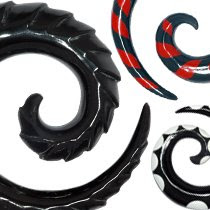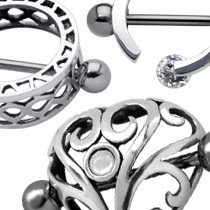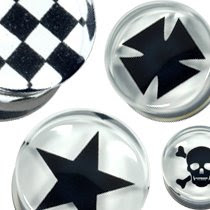A fresh stretch will be tender and may swell for the first few days, so you may decide to use a cold compress if this makes you feel more comfortable.
You can follow a daily salt solution soak while your stretch is healing, to keep the area clean and free of any debris (dead skin cells will build up if you do not clean your piercings regularly). If you are making your own salt solution, it is recommended you use Sea Salt and (either bottled, still water or) boiled water (cooled down) with about ¼ teaspoon of salt to 8oz (250ml or 1 cup) of water. Too much salt will dry your piercing out and cause irritation. A good reference to go by is to keep the salt solution no stronger than the taste of your tears!
We highly recommend our very own Body Jewellery Shop Saline Solution for quick and easy use, anywhere and anytime! Only £2.99!
 What materials are best for stretching my piercings?
What materials are best for stretching my piercings?
The best materials to use for a fresh stretch are Surgical Steel, Titanium (including Blackline and Zircon Gold) or Glass. These materials are non-porous (such as acrylic and wood). Porous materials are not recommended for use until your stretch is fully healed to prevent any skin reactions with your bodily fluids throughout the healing process.
How do I take care of a fully healed stretched piercing?
Once you have reached a stage at which you are happy to stop at, you will have the opportunity to shop around for a wonderful selection of Flesh Plugs and Tunnels to wear in your new modification! You will also be able to choose from a variety of double-flared jewellery (where the outer lip is larger than the size of your stretch, keeping the jewellery securely in place without any o-rings or screw-tops). To wear double flared jewellery, your stretch must have the chance to heal for several months whilst your skin will settle and gradually loosen up to allow for the larger flare to slide through without causing damage.
Visit the BodyJewelleryShop Gallery to view more piercing photos!
You will notice that over a longer period of time, you will be able to comfortably take your jewellery out for several hours each day without the hole reducing in size. There are many benefits to this, as your piercing will be given the chance to breathe and relax (encouraging good blood flow, oxygen, nutrients and removing any stress from the jewellery you wear each day). Some people are eventually able to remove their jewellery for a day or night, usually at larger gauges (over 12mm) as the skin has lost enough elasticity not to close up within this period of time.
If you have trouble getting your jewellery back into your stretch after leaving it out, there is no need to worry! Just use a hot compress for 5-10 minutes and use some lubrication to insert the jewellery back in again. Your stretch should ease up again in no time.
Make sure to clean your jewellery and piercings regularly, at least once a day (more so in hotter conditions and summer months). This will prevent any build up of dead skin cells, which eventually begin to smell if left to linger!
Try to moisturize your stretched piercing regularly, having a good routine (such as after every shower) will keep your piercings healthy and supple. Vitamin-E oil is a popular choice, as well as Savlon, E45 and Nivea (do not use scented oils and moisturizers as they could cause irritation).













